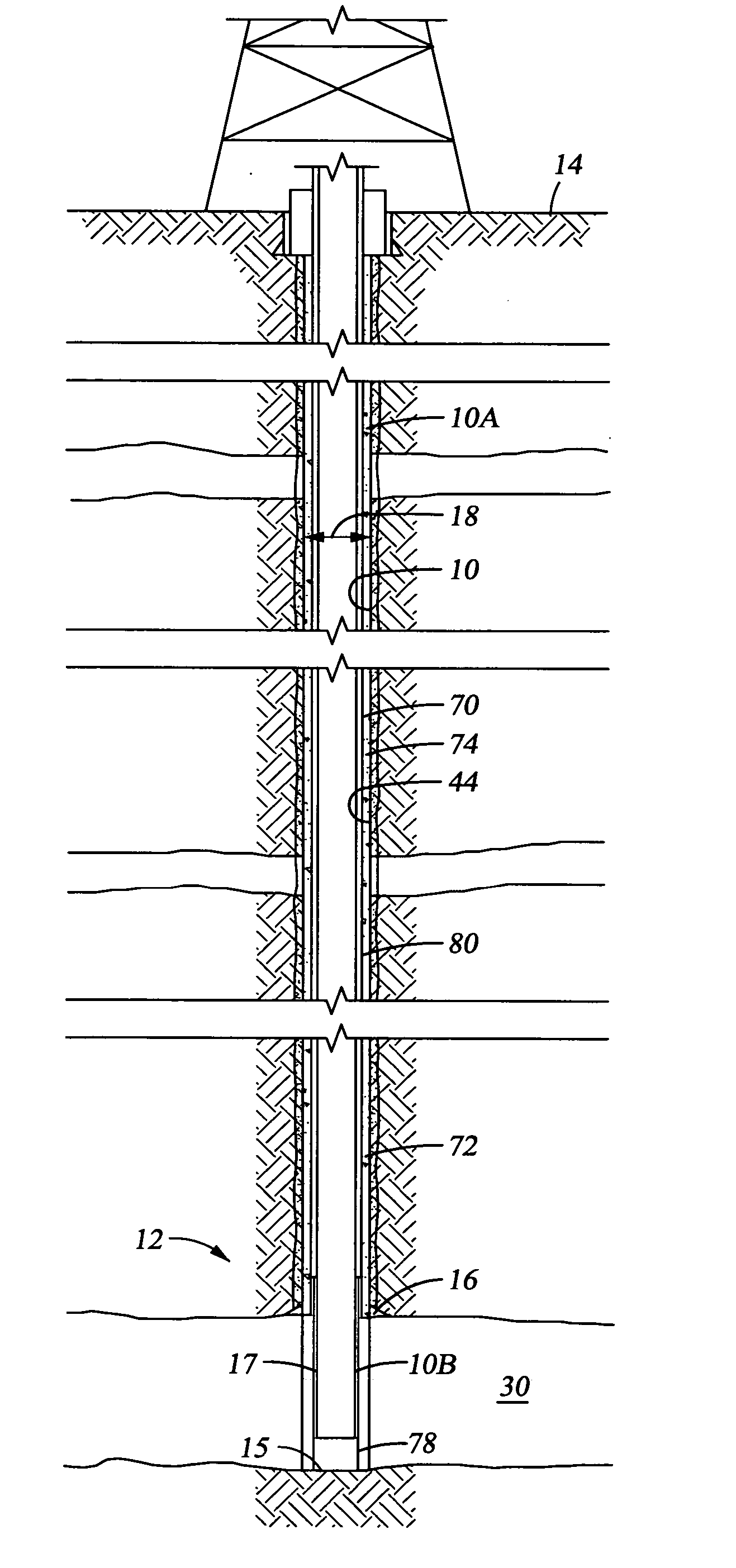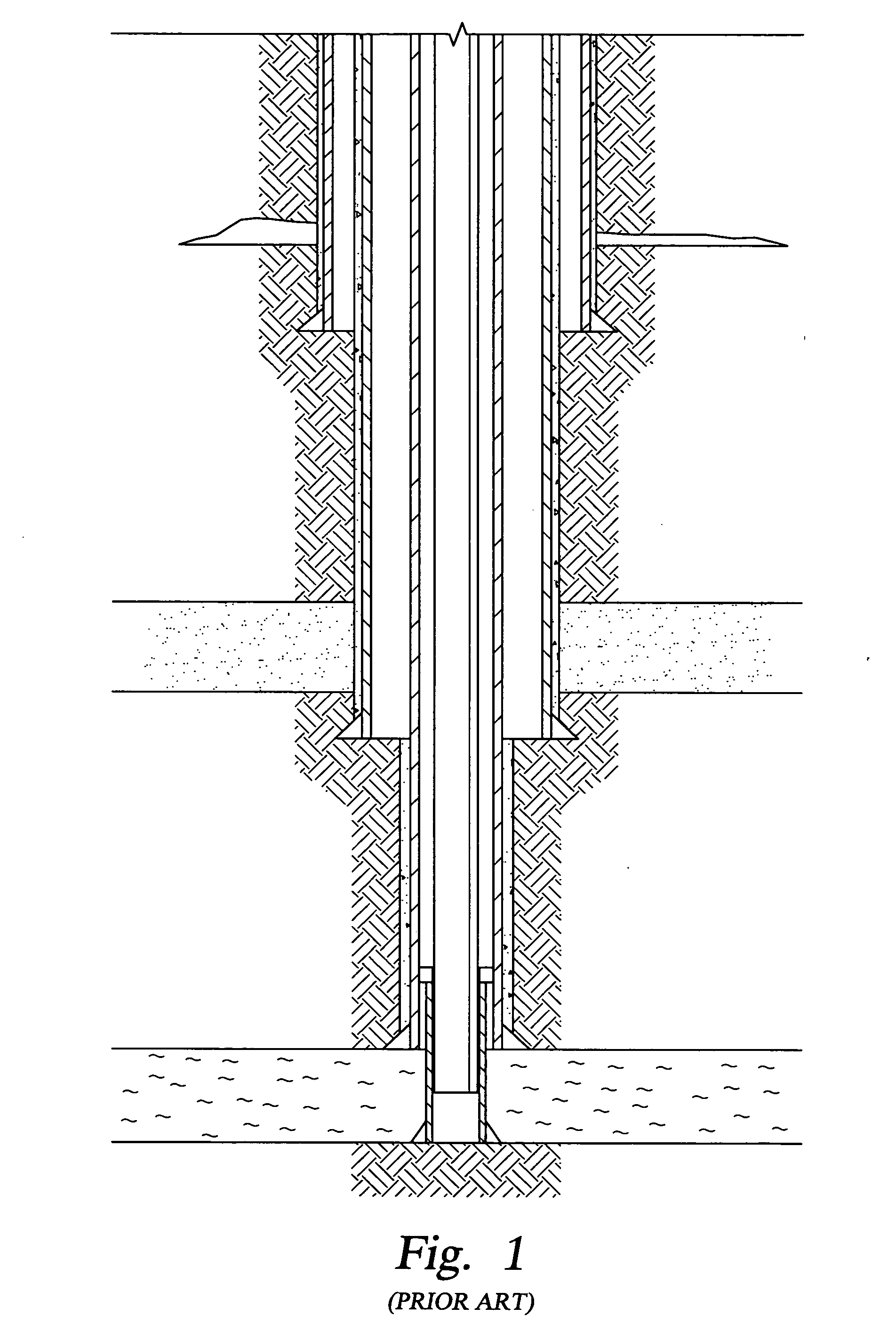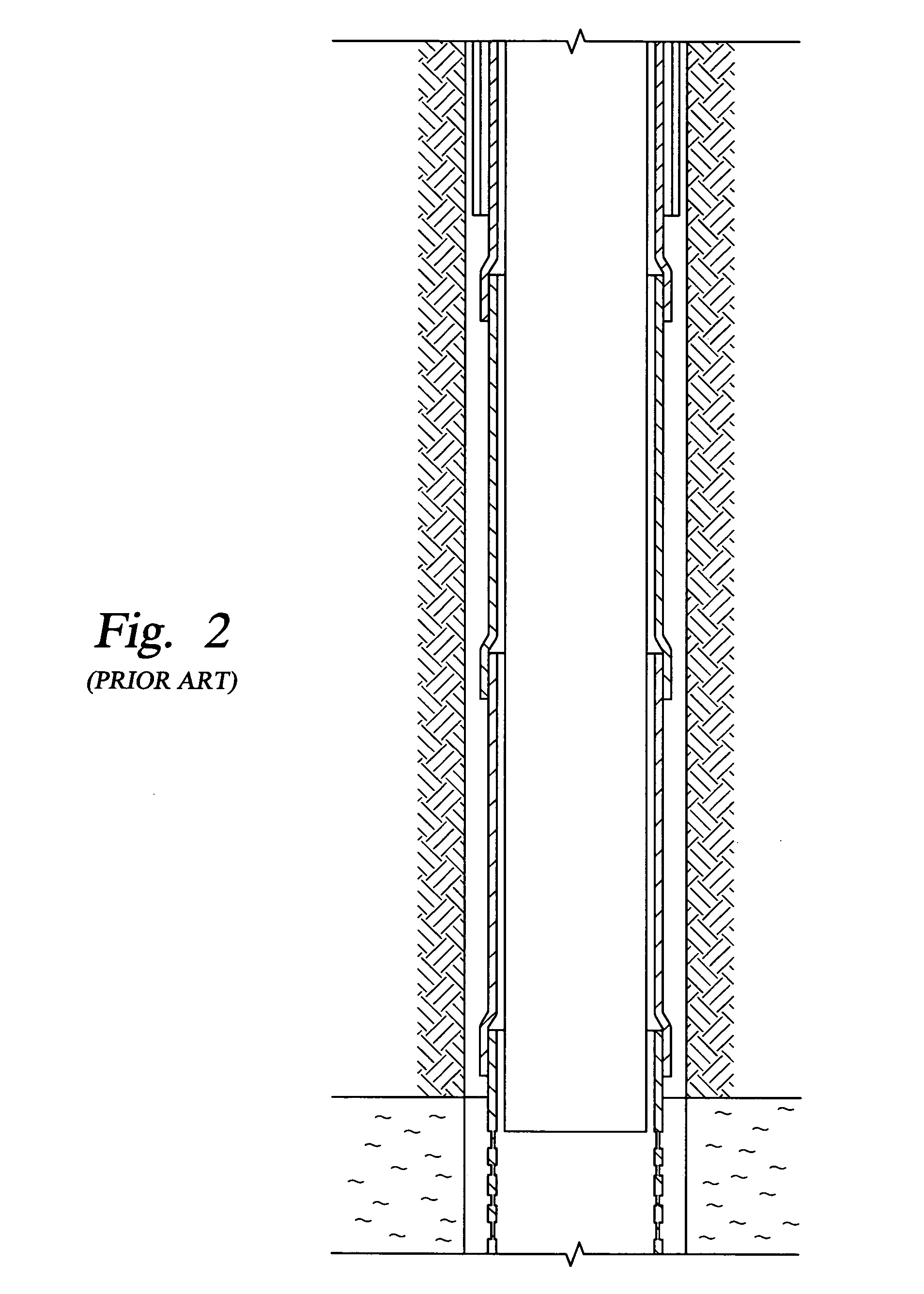If the driller encounters an extended series of
high pressure / low pressure intervals, the number of liners required under such circumstances may be such that the well cannot usefully be completed because of the continued reduction of the casing diameters required.
Along with the downsize serial casing operations, the production tubulars may have to be downsized as well further reducing the delivery capacity of the well.
The casing insert may not be possible, requiring that the well be sidetracked, resulting in a substantial reduced
diameter wellbore.
The disadvantages of nesting casing and liners is apparent in slim-hole drilling.
Over time, the formation may collapse and settle against the outer wall of the liner so that the area around the liner gets filled with
particulates.
A problem generally encountered during cementation of the casing is, that due to various factors, such as the existence of varying pressure and temperature gradients along the length of the casing and shrinkage of the
cement body during hardening thereof, relative displacements occur between the casing and the hardened
cement mass which may result in poor bonding or
cracking between the
cement body and the casing.
Poor bonding may result in the presence of a so-called micro-annuli between the casing and cement body, micro-annuli may extend along a substantial part of the length of the casing.
The occurrence of a micro-annuli is particularly dangerous in gas wells as substantial amounts of gas might escape to the surface.
This condition may also lead to surface or ground water
contamination.
The resulting problems are very expensive to correct.
The poor bonding of the cement may be attributed to
drilling fluid contamination or to bonding of the cement to the casing after the cement has set and / or oil or
mill finish contamination on the surface of the casing or it can be attributed to aggressive drilling or aggressive pressure subjection and large pressure differs prior to it hardening and during the operation.
A more fundamental cause is the loss of
hydrostatic head during the curing of the cement such that the formation pressure exceeds the annulus pressure and gas migration occurs causing channeling of the cement and subsequent leakage.
This technique, however, results in a lower strength cement.
These specialized cement additives are expensive and require specific operational techniques.
Further, a borehole may be drilled through the riser and
wellhead and through a problematic formation to extend a structural casing through the problem formation.
Large boreholes are disadvantageous in that they generate large amounts of cuttings and require increased volumes of
drilling fluid and cement.
Generally speaking, larger borehole sizes take longer to
drill than smaller
diameter boreholes at equivalent depth.
For example, increased drilling rig time is involved due to required cement pumping and cement hardening.
Further, a large borehole
diameter often takes larger fluid and
horsepower capacity rigs generating increased costs due to heavy casing handling equipment and large
drill bits.
Utilizing a large borehole often causes the usage of a wide variety of equipment and fluids that might not achieve
maximum efficiency for the drilled borehole.
Further, the large risers add substantial expense and additional large sized completion equipment.
The challenge to the industry is to develop the full suite of enabling and complimentary technologies that will be required to
drill and complete a monodiameter well.
However, the collapse strength of a post expanded tubular is less than that of the pre-expanded tubular but it is within the design limits expected for the required borehole pressures.
A simple expansion of
metal against
metal does not provide a reliable seal.
However, cement is undesirable for use with expandable casing.
Oilfield cement or hydraulic cement compositions are incompressible and tend to
resist the expansion of the casing or liner making the expansion more difficult.
Thus, expansion of the casing / liner can lead to the crushing of the cement, and consequent loss of effectiveness regarding the zones.
This problem is exacerbated by the small annular clearance associated with expandable casing / liners.
Conventional cement will be particularly brittle and weak in such thin sheaths or thicknesses and is hence an inappropriate sealing medium.
Other problems may be encountered using oilfield cement or hydraulic cement as the sealing composition for expandable casing / liners.
In a severely washed out borehole, such as soft formations with wash outs and ledges, the
sealant material may not be adequate.
Thus there is a much longer time period than in conventional drilling during which the borehole wall is unsupported by casing during drilling.
However, in order to insure that fracturing of low
mechanical strength formations penetrated by the well bore and other similar problems do not occur, it may become necessary to case and cement the borehole.
Another problem that occurs in the drilling and completion of well bores is that when the well bore is drilled into and through unconsolidated weak zones or formations.
Unstable materials such as clays, shales, sand stone and the like make up a high percentage of the formations in which wells are drilled, and a majority of well bore problems are a result of the
instability of such materials, particularly shale
instability.
Such shales upon contact with aqueous drilling fluids swell and fracture rendering the well bore wall unstable.
Sloughing of shale and other similar unstable materials into the well bore can cause the
drill string to become stuck and can enlarge the well bore resulting in large subterranean cavities.
Additionally, when sloughing occurs while the
drill bit is being changed at the surface, the well bore fills up and must be cleared before drilling can proceed.
Furthermore, the heaving unstable material suspended in the
drilling fluid increases its
solid content, and as a result, the
viscosity of the drilling fluid increases to the point where the drilling fluid must be chemically treated to reduce its
viscosity or it must be diluted followed by the addition of weighting material to maintain its
mud weight.
The
instability of clays, shales, sand stone and the like is also caused by
hydraulic pressure differential leading to
fluid transport and by pressure changes near the well bore as the drilling fluid compresses
pore fluid and diffuses a pressure front into the formation.
Such fractures cause drilling fluid to be lost and also require stoppage of the drilling operation and costly remedial steps to be taken.
Each restriction in the completion tubulars causes a pressure drop across that point causing scale and
corrosion to occur at these points.
The narrowing of the completion tubulars also reduces flow and therefore production.
 Login to View More
Login to View More  Login to View More
Login to View More 


